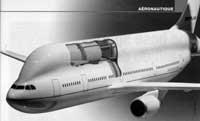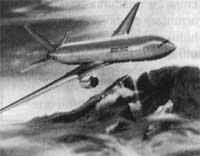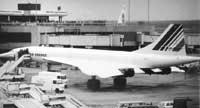“Green” plane ready to take off
1997/07/01 Elhuyar Zientzia Iturria: Elhuyar aldizkaria
Today's aircraft only support 1.5% of global energy consumption, but cause a serious ecological problem due to pollution of the upper atmosphere (the weakest). One solution is to use planes that run on liquid hydrogen or liquid natural gas. Hydrogen becomes liquid at -253 (C) and natural gas at -160 (C). With this system, in addition, the engines of the current aircraft would take advantage with some changes.
This idea began to be worked on in the Soviet Union as a result of the oil crisis of 1973. Then a plane propelled with liquid natural gas was projected. Research began in 1975 and on April 15, 1988, the experimental plane was launched. Tupolev 155 of three engines was a normal model, but one of the engines had changed when it was wanted to run on hydrogen and natural gas when wanted. The results were satisfactory, so the program advanced and around 1990 began to collaborate with the German industry.

At present Russia is the most advanced in this field. The three engines run on kerosene or liquid natural gas and have three finished Tu 156 aircraft. Natural gas has been chosen and not hydrogen, because in Russia this fuel is abundant and needs less infrastructure. The Mosku-Samara-Rechta road will be carried out with load. When they leave Moscow the apparatus will burn kerosene. Rechta is the northern city of Siberia and due to its large reserves of natural gas, the planes will burn liquid natural gas at their departure. This year they want to make their first flight and if successful they will start transporting passengers.
The Germans have embarked on the path of liquid hydrogen, a clean and inexhaustible type of energy. Natural gas and hydrogen have the same technical problems and the solutions are similar. The Dasa House, belonging to the Daimler-Benz Aviation Department, wants to enter into a collaboration agreement with Russians and Canadians. It is about using the Dornier Do-328 two-engine turboprop by changing a motor. Liquid hydrogen will be stored in deposits on the slopes and the first flight is scheduled for 2000. If the sessions are successful, in 2006 the Airbus A310 would run on hydrogen.
But hydrogen has certain difficulties. It occupies a volume four times greater than the kerosene in the same mass, so the deposits would move on passengers and not on wings. On the other hand, the maintenance of hydrogen at a pressure of 1.5 atmospheres and at a pressure of -253-C also presents difficulties.
The advantages of hydrogen are important. In the same mass it provides 2.8 times more energy than kerosene and the A310 Airbus would carry 319 passengers instead of 243. On the other hand, hydrogen is an inexhaustible source that comes out of the water and when burned does not emit CO 2, but water vapor. Nitrogen oxides can also emit 95% less.

Gai honi buruzko eduki gehiago
Elhuyarrek garatutako teknologia






